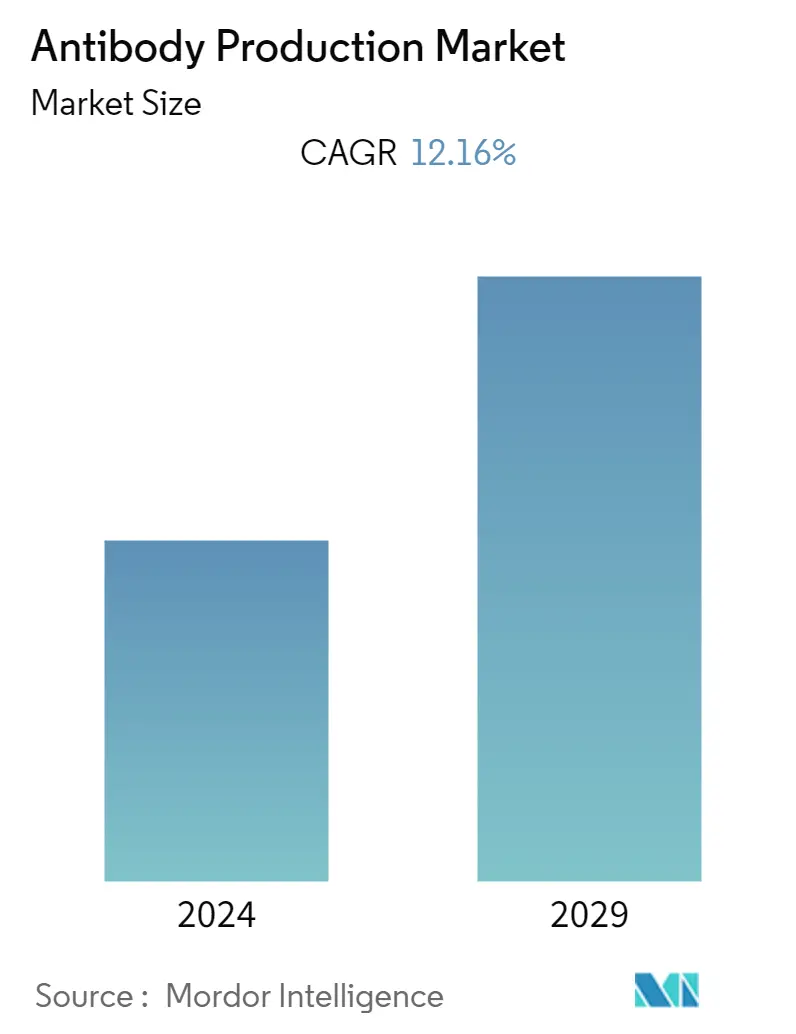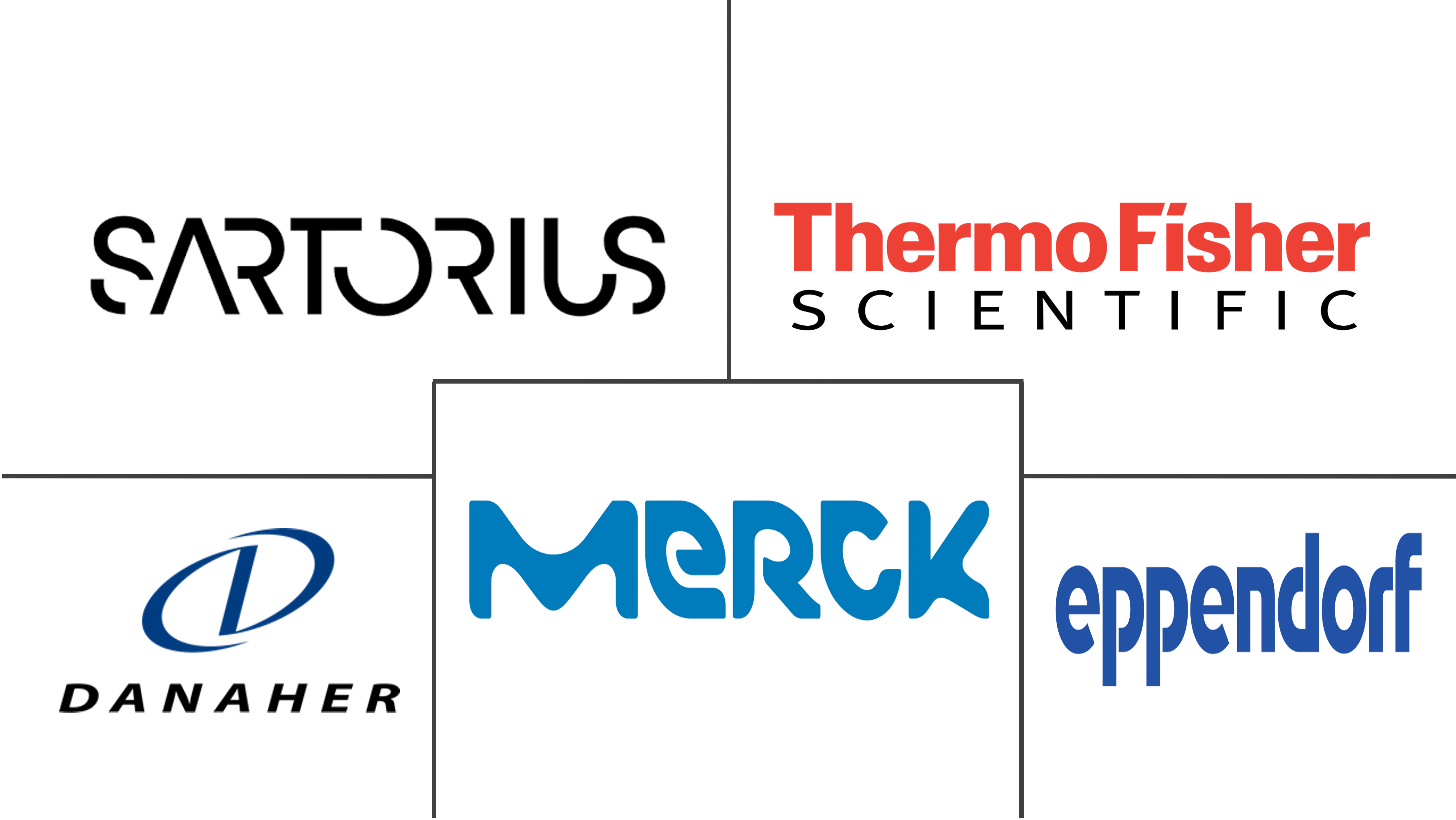Market Size of Antibody Production Industry

| Study Period | 2019 - 2029 |
| Base Year For Estimation | 2023 |
| CAGR | 12.16 % |
| Fastest Growing Market | Asia-Pacific |
| Largest Market | North America |
| Market Concentration | Medium |
Major Players
*Disclaimer: Major Players sorted in no particular order |
Antibody Production Market Analysis
COVID-19 had a significant impact on the antibody production market. The government-imposed lockdowns, supply chain disruption, and trade bans in several countries significantly reduced antibody production during the initial phase of the pandemic. However, the emergency use authorization (EUA) for monoclonal antibodies as a treatment against COVID-19 by healthcare organizations increased the demand for antibody production in the industry. For instance, the United States COVID-19 Treatment Panel recommended the use of monoclonal antibodies for treating the SARS-CoV-2 variants, such as Bebtelovimab 175 mg intravenous injections, Bamlanivimab, etesevimab, and a few others. Therefore, the demand for antibodies has been increasing in the past few years. The trend is expected to continue in the forecast period owing to the long-term impact of COVID-19 on a person's health.
The major factors for the growth of the antibody production market include the rising adoption of targeted immunotherapy, the increase in the R&D expenditure of pharmaceutical and biotechnology companies, and the rising demand for therapeutic antibodies.
Antibodies are used in the treatment of various diseases, such as cancer, rheumatoid arthritis, and other chronic diseases. The targeted therapy is attaining importance due to its specificity toward cancer cells while sparing the toxicity to off-target cells. As there is a rising prevalence of cancer, targeted therapies are getting more attention. For instance, as per the Australian Institute of Health and Welfare (AIHW) 2021 report, a total of 150,782 new cancer cases were estimated in Australia in 2021. Out of the total number of cancer cases, breast cancer cases were estimated to be 20,030, lung cancer with 13,810 new cases, and prostate cancer 18,110 cases were estimated to occur in 2021. Some examples of monoclonal antibodies used in targeted therapies are bevacizumab, cetuximab, and ipilimumab. Hence with the high burden of cancer, the antibody production market is estimated to grow during the forecast period.
The rising adoption of targeted therapies is expected to propel the overall growth of the antibody production market over the forecast period. The success rates and blockbuster sales of biologics have also made large pharmaceutical companies shift their presence to biopharma. Over the past two decades, the chimerization and humanization of mAbs (monoclonal antibodies) have led to the approval of several drugs & therapies for the treatment of autoimmune diseases, cancer, and transplant rejection. For instance, in August 2022, the FDA approved Enhertu (fam-trastuzumab-deruxtecan-nxki), an IV infusion for the treatment of patients with unresectable or metastatic HER2-low breast cancer. It is one of the first approved targeted therapy. Such approvals highlight the need and demand for the treatment of life-threatening diseases like breast cancer which is further expected to augment the market growth during the forecast period.
Therefore, owing to the factors such as the high prevalence of diseases requiring targeted therapies and rising product launches by key players, the studied market is anticipated to witness growth over the analysis period. However, the high cost involved in antibody production and stringent government regulations is expected to impede the growth of the market.
Antibody Production Industry Segmentation
As per the scope of the report, antibody production refers to the process of creating a specific antibody. In a broad sense, it consists of various methods, such as upstream, downstream, and filtration. The process involves the preparation of antigen samples, which are injected into the laboratory or farm animals to evoke high expression levels of antigen-specific antibodies in the serum, which are then recovered from the animal. The Antibody Production Market is Segmented by Antibody Type (Monoclonal Antibodies, Polyclonal Antibodies, Other Antibody Types), Process (Upstream Processing, Downstream Processing, Filtration), End User (Pharmaceutical and Biotechnology Companies, Research Laboratories, Other End Users), and Geography (North America, Europe, Asia-Pacific, Middle East, and Africa, and South America). The report also covers the estimated market sizes and trends for 17 countries across major regions globally. The report offers the value (in USD million) for the above segments.
| By Antibody Type | |
| Monoclonal Antibodies | |
| Polyclonal Antibodies | |
| Other Antibody Types |
| By Process | ||||
| ||||
| ||||
| Filtration |
| By End User | |
| Pharmaceutical and Biotechnology Companies | |
| Research Laboratories | |
| Other End Users |
| Geography | ||||||||
| ||||||||
| ||||||||
| ||||||||
| ||||||||
|
Antibody Production Market Size Summary
The antibody production market is experiencing significant growth, driven by the increasing demand for targeted immunotherapy and therapeutic antibodies. The market's expansion is largely attributed to the rising prevalence of diseases such as cancer and chronic conditions, where antibodies play a crucial role in treatment. The COVID-19 pandemic initially disrupted the market due to lockdowns and supply chain issues; however, the emergency use authorization of monoclonal antibodies for COVID-19 treatment boosted demand. This trend is expected to continue as the long-term health impacts of COVID-19 persist. The market is further propelled by the growing research and development investments by pharmaceutical and biotechnology companies, which are focusing on developing advanced monoclonal antibodies for various applications, including cancer treatment and autoimmune diseases.
North America is anticipated to hold a significant share of the antibody production market, supported by a high prevalence of cancer and a robust healthcare infrastructure. The region benefits from numerous product launches and innovations by key market players. The approval of new antibodies for cancer treatment and other diseases is contributing to market growth, with companies expanding their manufacturing capacities to meet rising demand. The market is characterized by a consolidated nature, with a few major companies dominating both global and regional markets. Strategic collaborations and investments in research and development are expected to further drive the market, despite challenges such as high production costs and stringent regulatory requirements.
Antibody Production Market Size - Table of Contents
-
1. MARKET DYNAMICS
-
1.1 Market Overview
-
1.2 Market Drivers
-
1.2.1 Rising Adoption of Targeted Immunotherapy
-
1.2.2 Increase in the R&D Expenditure of Pharmaceutical and Biotechnology Companies
-
1.2.3 Rising Demand for Therapeutic Antibodies
-
-
1.3 Market Restraints
-
1.3.1 High Costs Involved in the Antibody Production
-
1.3.2 Stringent Government Regulations
-
-
1.4 Porter Five Forces
-
1.4.1 Threat of New Entrants
-
1.4.2 Bargaining Power of Buyers/Consumers
-
1.4.3 Bargaining Power of Suppliers
-
1.4.4 Threat of Substitute Products
-
1.4.5 Intensity of Competitive Rivalry
-
-
-
2. MARKET SEGMENTATION (Market Size by Value - USD million)
-
2.1 By Antibody Type
-
2.1.1 Monoclonal Antibodies
-
2.1.2 Polyclonal Antibodies
-
2.1.3 Other Antibody Types
-
-
2.2 By Process
-
2.2.1 Upstream Processing
-
2.2.1.1 Bioreactors
-
2.2.1.2 Consumables
-
-
2.2.2 Downstream Processing
-
2.2.2.1 Chromatography Systems
-
2.2.2.2 Chromatography Resins
-
-
2.2.3 Filtration
-
-
2.3 By End User
-
2.3.1 Pharmaceutical and Biotechnology Companies
-
2.3.2 Research Laboratories
-
2.3.3 Other End Users
-
-
2.4 Geography
-
2.4.1 North America
-
2.4.1.1 United States
-
2.4.1.2 Canada
-
2.4.1.3 Mexico
-
-
2.4.2 Europe
-
2.4.2.1 Germany
-
2.4.2.2 United Kingdom
-
2.4.2.3 France
-
2.4.2.4 Italy
-
2.4.2.5 Spain
-
2.4.2.6 Rest of Europe
-
-
2.4.3 Asia-Pacific
-
2.4.3.1 China
-
2.4.3.2 Japan
-
2.4.3.3 India
-
2.4.3.4 Australia
-
2.4.3.5 South Korea
-
2.4.3.6 Rest of Asia-Pacific
-
-
2.4.4 Middle East and Africa
-
2.4.4.1 GCC
-
2.4.4.2 South Africa
-
2.4.4.3 Rest of Middle East and Africa
-
-
2.4.5 South America
-
2.4.5.1 Brazil
-
2.4.5.2 Argentina
-
2.4.5.3 Rest of South America
-
-
-
Antibody Production Market Size FAQs
What is the current Antibody Production Market size?
The Antibody Production Market is projected to register a CAGR of 12.16% during the forecast period (2024-2029)
Who are the key players in Antibody Production Market?
Sartorius AG, Danaher Corporation, Merck KGaA, Eppendorf AG and Thermo Fisher Scientific are the major companies operating in the Antibody Production Market.

